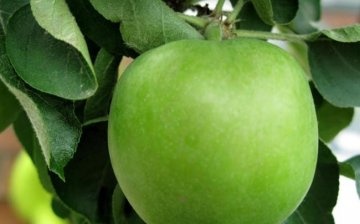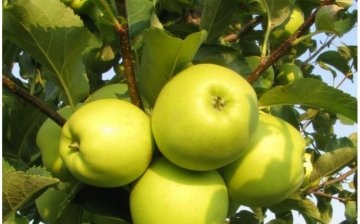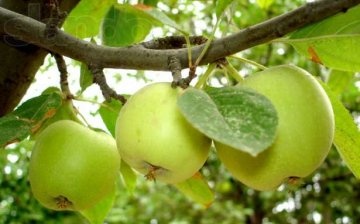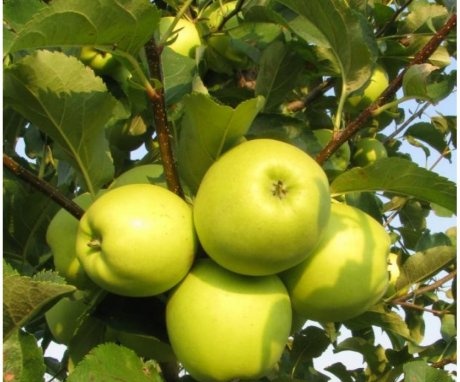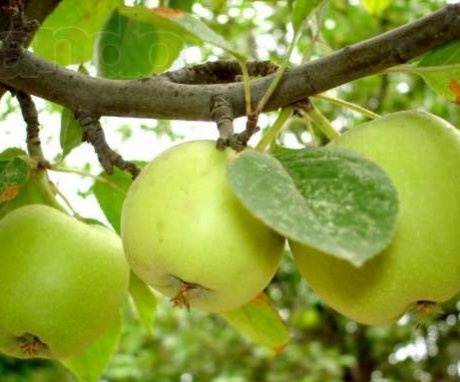Apple tree Simirenko: features of the variety, conditions of care and cultivation
To grow an apple tree that will give a big harvest, you need to follow the rules of care. The Simirenko variety has its own characteristics that need to be remembered.
Content:
- What is the Semerenko apple variety
- How to properly care for an apple tree
- The best way to propagate an apple tree
What is the Simirenko apple variety
The variety has a scientific name - Renet Simirenko. Who exactly bred the variety and how it appeared in nature is still unknown. The name of the variety was given by L.P.Semirenko, he also described it and entered it into the catalog. But the father of the scientist Platon Fedorovich Semirenko discovered and began to propagate the apple tree.
In the literature, the name is written in different ways: Simirenko, Semerenko, Simerenko, etc.
The variety is difficult to confuse with others, it has its own characteristic features:
- The Simirenko apple tree gives a high yield, has high taste and market qualities, the fruits are large and light. That is why the cultivation of this variety is so popular among amateur gardeners and farmers.
- Harvesting begins in late September - early October, these dates are medium late for apple trees. The Antonovka variety is self-fertile, the tree is medium-sized.
- The variety belongs to winter, it has an average winter hardiness, fast-growing.
- As for the fruits, they are large, the maximum weight is 200 grams, the average is 150-180 grams. The fruit is round-conical, light green in color, there are many light subcutaneous points. The flesh of the Simirenko apple tree has a light green tint, dense, juicy, has a pronounced aroma, fine-grained, sweet and sour in taste.
If you store the apple tree for a long time, then the pulp becomes more creamy, denser and more juicy. For 7-8 months of storage of fruits in cool conditions, in a cellar or refrigerator, nothing will happen to apples, for such a period they will not wither.
The Simirenko variety needs a normalized ovary and protection from fungal parasites.
The cultivar's resistance to scab and powdery mildew is low. The variety tolerates drought well, does not react to wind and drafts. Simirenko also has disadvantages, for example, periodic fruiting of trees, condensed crown... In the south, frosts affect even the wood of the trunk, but the shoots quickly recover and begin to bear fruit after 3 years. On the contrary, the tree is resistant to heat.
After planting an apple tree in your area, you can expect fruits only in the 5-6th year. While the plant is young, it bears fruit every year, as it matures, they switch to periodic fruiting.
How to properly care for an apple tree
Apple tree pruning:
- The main feature of the Simirenko apple variety is a dense crown, this negatively affects fruiting, therefore, be sure to take care of the tree prune shoots.
- Pruning is carried out for any varieties with highly developed ringlets and low-growing trees.
- Varieties with poorly developed annulus and vigorous apple trees also need pruning, but to a lesser extent.
The Simirenko apple tree, while young, forms few ringlets, but at the same time, fruit buds are formed in large numbers on annual growths. Therefore, at an early age, in the Simirenko apple tree, only strong growths are shortened, the length of which is more than 60 cm.
If you do not provide the apple tree with special conditions, then you can not count on a good harvest and high taste of the fruit.
The following activities are provided as care:
- Regular watering.
- Fertilization.
- Pruning.
- Preparing for winter.
For apple tree need to prepare suitable soil, a hole is dug 60 cm deep and about 1 m in diameter. Organic fertilizers are added to the soil that was dug out of the hole. The soil for the apple tree is more acidic, the groundwater should flow as close to the roots as possible.
When planting, the root collar should look a few centimeters out of the soil. If the soil is sandy, then clay is placed in the pit, and on top of it plant residues with a layer of up to 15 cm. Further, humus, peat and previously removed soil with fertilizer are spread in the pit in an equal amount.
Immediately after planting, the apple tree is watered, 3-4 buckets of water will be enough.
The tree is tied up. In the phase of active growth, apple trees are fertilized, compost or manure is applied under the tree, 50 kg of fertilizer is enough per hundred square meters. This fertilizer is applied every other season.
Apple fertilizer:
- More often manure is applied in the fall, in addition to it, mineral fertilizers are used.
- In the spring, nitrogen fertilizers are applied, they are necessary for good vegetation.
- Ammonium sulfate or ammonium nitrate is superficially laid out.
- On the border of the near-trunk circle, phosphorus fertilizers are applied into grooves 30 cm deep.
In order for the apple tree to endure the winter well, the soil of the trunk circles is mulched.
Peat, humus or compost are taken as mulch. This activity is most necessary for trees with dwarf rootstocks and a shallow root system.
Since the trunks of the apple tree can be damaged by rodents and hares, the tree is tied. This is done every year until the trunk is overgrown with strong bark. Also, the trunks can be covered with chalk or lime whitewash.
The best way to propagate an apple tree
The apple tree propagates in two ways: by seed and cuttings.
Seed propagation is practically not used, only in rare cases, for the development of new varieties. To breed a new variety, pollen from a tree of one variety transferred to the flowers of another, the result is unpredictable properties. High-quality fruits on such a plant will not appear soon, and in order to make a good selection, it will be necessary to sort out hundreds of individuals.
Much easier to implement propagation by green cuttings:
- The resulting apple tree has its own roots, there is no risk of not combining the scion and rootstock, self-renewal is possible in the event of the death of the aboveground part. Compared to conventional seedlings, greens are more durable and productive.
- The cuttings are cut when they have reached a sufficient length and have just begun to lignify, but do not break when bent, but remain elastic. The optimal time for harvesting cuttings is mid - end of June.
- The stalk is cut to a length of 8-10 cm, plus or minus 2 cm. There should be at least 4 leaves on the shoot. The cut is done with a sharp knife or razor
- In order for the stalk to give roots as quickly as possible, it is dipped a third of its length in a solution of heteroauxin and kept in it for 10 hours. For one liter of hot water, 1.5 tablets of heteroauxin are used. If you dip the cuttings in the solution in the morning, then in the evening you can start planting them.
- Soil for cuttings It is prepared as follows: humus soil or leafy moisture-absorbing soil is taken, a peat-sandy substrate of several centimeters is laid on top. Cuttings are planted 4 cm deep, a mini-greenhouse made of film or glass is installed at a height of 15 cm. The greenhouse will maintain high humidity and temperature.
- The best temperature for rooting cuttings is 23-30 degrees. The place should be bright. There should be a distance of 5 cm between the cuttings, and 10 between the rows. The larger the leaves on the future tree, the greater the distance should be.
The cuttings need to be watered regularly, and when rooting occurs, they begin to feed with phosphorus, potassium and nitrogen.
Cuttings are planted in separate containers for growing or immediately to a permanent place. Apples of the Simirenko variety have high taste... They are easy to distinguish from other varieties by their appearance. Growing rules remain the same for all varieties.
More information can be found in the video.



